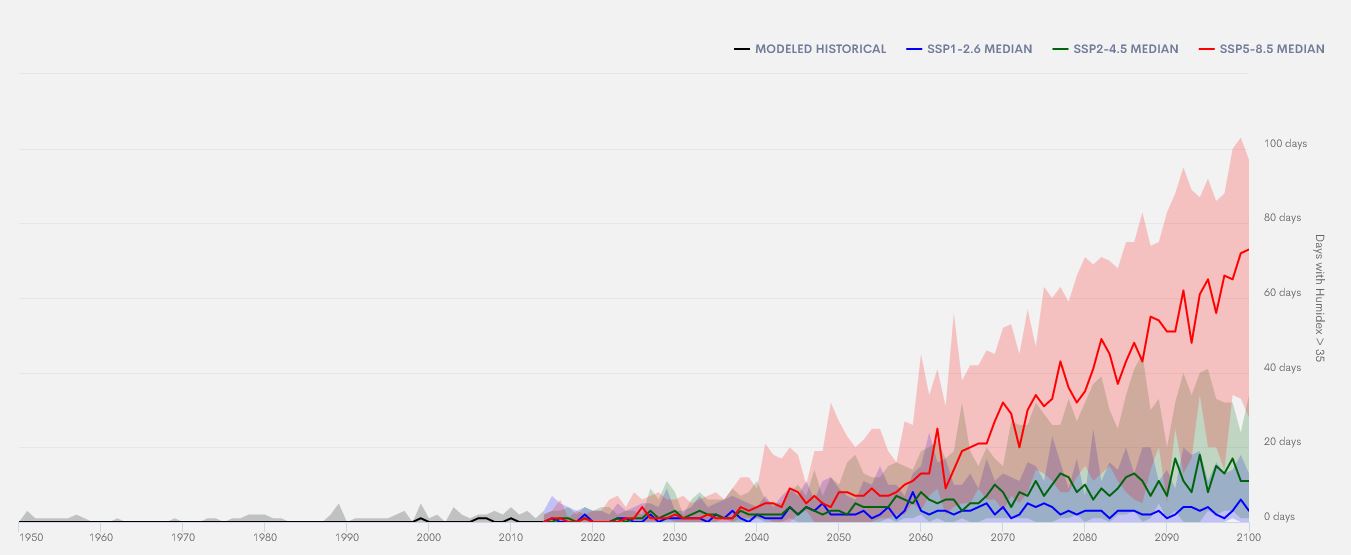Humidex Projections
Humidex is important for understanding how summer weather can impact human health by combining the effects of temperature and humidity on the human body. Therefore, Humidex can help us better understand how we actually feel on a hot summer day. When the Humidex is high, our bodies have a harder time cooling down, which can lead to heat exhaustion or even heat stroke. As the planet continues to warm due to climate change, understanding how Humidex will change in the coming decades is critical for public health officials, emergency planners, and anyone who wants to stay safe and healthy during summer extreme weather events. Until very recently, future projections of Humidex were not widely available; however, that is thankfully no longer the case!
To help us better understand how Humidex might change due to climate change, researchers at Environment and Climate Change Canada have developed a new dataset that provides future projections for Canada. The dataset includes information on the daily maximum Humidex and three Humidex threshold indices: the annual number of days when the maximum Humidex exceeds 30 (some discomfort), 35 (discomfort), and 40 (great discomfort). These different thresholds help reflect the fact that different people respond to humidity differently, depending on where they live or to what conditions they are accustomed. The dataset covers the years from 1950 to 2100 and includes information from 19 different climate models at a spatial scale of approximately 9 x 11 km.
Map of Days with Humidex > 35
Click here to explore this map in more detail.
These climate models are part of the latest phase of the Coupled Model Intercomparison Project (CMIP6). Data for other climate variables from CMIP6 models were recently added to ClimateData.ca. Just like the other maps and data on the website, the Humidex data is provided for three “Shared Socioeconomic Pathway” (SSP) scenarios: SSP1-2.6, SSP2-4.5, and SSP5-8.5.
Learn more: what are Shared Socioeconomic Pathways (SSPs)?
The new Humidex dataset provides valuable information for policymakers, planners, and the general public who are concerned about the impacts of climate change on their communities. The dataset contains projections of how often people will experience discomfort, caution, or extreme caution days due to hot and humid weather under different future warming scenarios. Humidex data is also important for public health and climate adaptation planning because humidex can be experienced differently by different populations: for example, seniors and children may be more vulnerable at lower thresholds than the general population.
One interesting finding from the dataset is that many locations across Canada will likely experience more and more frequent “extreme caution days” per year. In addition, new regions, which historically were not used to facing high Humidex values, could start to experience them, especially under the high emissions (SSP5-8.5) scenario. This means that more and more Canadians will experience dangerously hot and humid weather in the future and human thermal comfort will become an important issue that will need to be addressed by public health and community planners in many more regions of the country if greenhouse gas emissions continue to rise.
Possible adaptation actions to limit the impacts of this trend include reducing the built environment’s contribution to urban heat, developing or updating existing heat warning plans and systems, adapting to both chronic and acute heat risk through new heat management strategies, increasing access to cooling for everyone in affected areas, and planning investments for cities to adapt to a more hot and humid climate.
Overall, the new Humidex dataset is a valuable contribution to understanding how climate change will impact Canada’s summer weather and the health of Canadians in the coming decades. It provides detailed projections for different parts of the country under different greenhouse gas emissions scenarios, helping us make informed decisions about how to adapt to and mitigate the impacts of climate change.
References
Diaconescu, E., Sankare, H., Chow, K., Murdock, T. Q., & Cannon, A. J. (2023). A short note on the use of daily climate data to calculate Humidex heat-stress indices. International Journal of Climatology, 43( 2), 837– 849. https://doi.org/10.1002/joc.7833










